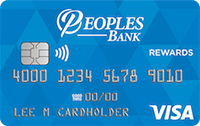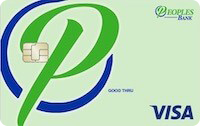Posted On: January 17, 2022 by Peoples Bank in: Financial Education Kids Friendly

It is estimated that 4 out of 7 adults in America are financially illiterate, and over 66% of Americans, 178 million people, are struggling financially.12 What if we could lay the right groundwork for today’s youth so that they can build a brighter financial future?
Exposing children to financial education at an early age sets children up for a healthier financial future. Learning about pennies, nickels and quarters is as important as teaching the ABCs and 123s. So, when is the right time to talk to children about money, and how can you make it understandable and relevant to their everyday life?
This year, Peoples Bank and The GIANT PIGGY BANKTM program, an interest-earning children’s deposit account and student banking program, will be sharing a four-part series of helpful tips, information and activities on age-appropriate financial topics in partnership with Des Moines Parent, an online community for Central Iowa Parents. Parents or caregivers are encouraged to share these fun and informative financial activities with young children (ages preschool through 2nd grade). The first topic of the series covers the simple, yet important question to introduce to children: What is money?
What is money? : A Child-Friendly Answer
Life is full of great “free” things: going to a park, building a snowman, or playing with friends are a few. But a lot of other things in life are not “free”. Rather, money is used to purchase or buy most items and sometimes the things you do like a trip to the zoo or to see a movie at the theater. Your favorite toy and your favorite snack most likely required money to obtain. Money is made up of coins and paper money that represent different amounts. And while money doesn’t grow on trees, it can grow by earning and saving.
When to Introduce Children to Money
Did your child ask for a toy or candy recently? When you go shopping, is your child asking to put items in the cart? If so, then your child is old enough to start learning about money.
Where to Teach Your Children About Money
Everyday life offers plenty of teachable moments for your children. Taking your children to the grocery store, having them watch you deposit money at the bank, discussing plans for an upcoming vacation, or assigning chores around the house all provide real life moments to discuss the importance of earning and saving money in order to purchase future items or experiences.
What “Money Basics” You Should Talk About
To start, help your child(ren) recognize the names and values of different coins and bills. Use money you have on hand, play money or coloring sheets with examples of money. Learning to identify types of money will also help your child understand the relative purchasing power of each. Once they’ve learned the basics, by early elementary age, they can start learning how to count combinations of coins.
How to Help Children Understand Money
Discussing money during real-life teachable moments is a great way to keep the topic always top-of-mind. But, seeking out and organizing money-themed activities can be helpful and fun too. Here is a list of a few ideas:
- Coloring Sheet: Download our FREE children’s coloring sheet below which features various coins to identify and color. Submit your coloring sheet and entry form to Peoples Bank Clive or Waukee by Wednesday, March 16th for a chance to win up to $50. For more info go here.
- Treasure Hunt: Hide coins and have children find and identify each they find.
- Read Money-Themed Books: Go to the library or purchase books that discuss the basics of money. Here’s a good list to start with: https://www.the-best-childrens-books.org/teaching-money.html
- Play Store: Create a pretend store in your house. Give your child real coins or play money to purchase items. Develop an understanding of coin value by having smaller items cost a penny or nickel while larger items cost a quarter. As they get older, sell items that require a combination of coins and incorporate dollar bills. Switch who plays the “buyer” and who plays the “seller” so your child can practice exchanging and returning money.
- Snack Time Fun: Get out the goldfish, animal crackers or other small snacks. Give each child pennies and nickels (real or play money). For each goldfish, a child needs to pay one penny. Sell five goldfish in exchange for five pennies. Next, give them five goldfish for a nickel. Discuss with the child that five pennies is the same amount as one nickel.
- Open a Children’s Deposit Account: Take your child to the bank and open up his or her first saving’s account. Provide opportunities for your child to earn money so that they can make future deposits and discuss the importance of earning and saving. By making visits to the bank part of your family’s routine, your child will become aware of the importance of being a good financial steward of his or her money. For an interest-earning children’s deposit account, check out Peoples Bank’s The GIANT PIGGY BANKTM here.
Introducing the concept of money to children is the first step to building a brighter financial future for them. Keep an eye out for our next article in May which will discuss The Magic of Money-Making Decisions: The Importance of Nurturing Independent Financial Decision-Making.
Peoples Bank is a local, family-owned bank with nine locations in Central Iowa. The GIANT PIGGY BANKTM is our interest-earning children’s deposit account and student banking program in select schools that aims to provide financial literacy to children in the communities we serve. Learn more by visiting www.mypeoples.bank/personal/giant-piggy-bank
1. Fu, Chang. “32 Must-Know Financial Literacy Statistics in 2021.” Possible, 15 Feb. 2021, www.possiblefinance.com/blog/financial-literacy-statistics.
2. Financial Health Network. “2019 Trends Report.” U.S. Financial Health Pulse, 2019, p. 5, s3.amazonaws.com/cfsi-innovation-files-2018/wp-content/uploads/2019/11/13204428/US-Financial-Health-Pulse-2019.pdf.
3. Dickler, Jessica. “Giving Kids an Early Financial Education Pays off in the Future.” CNBC, 5 Apr. 2021, www.cnbc.com/2021/04/05/giving-kids-an-early-financial-education-pays-off-in-the-future.html.




